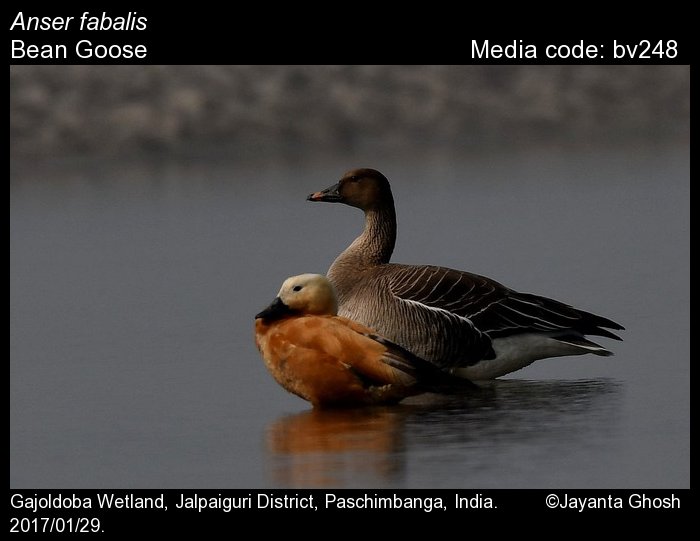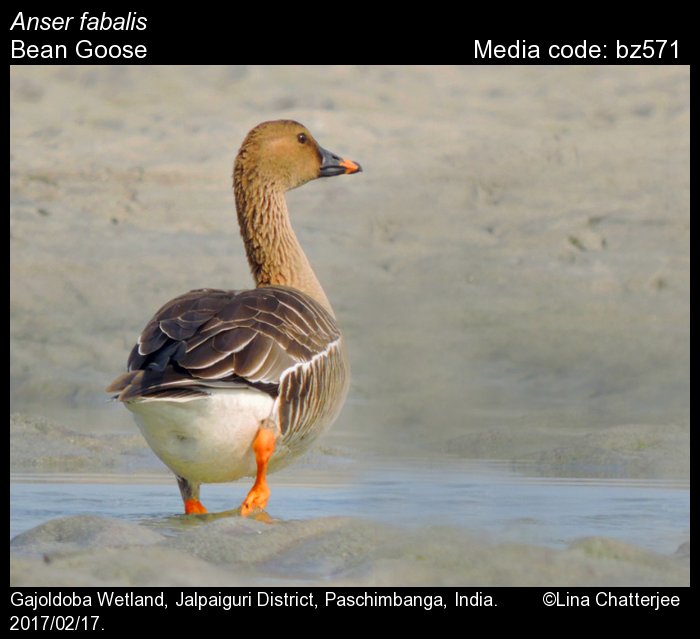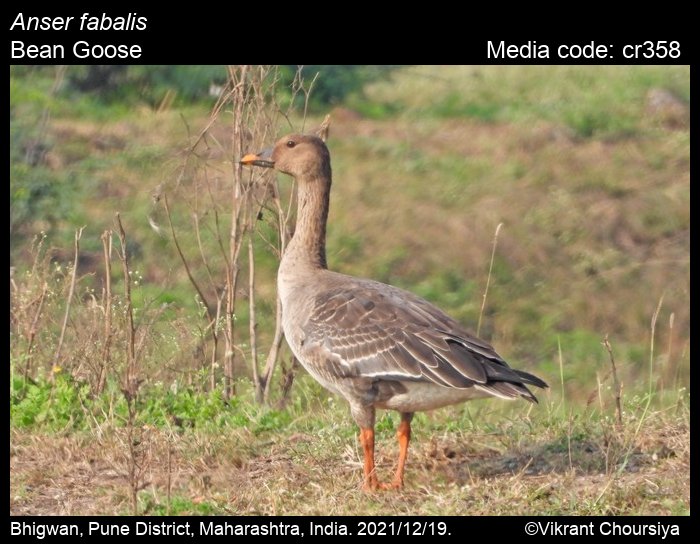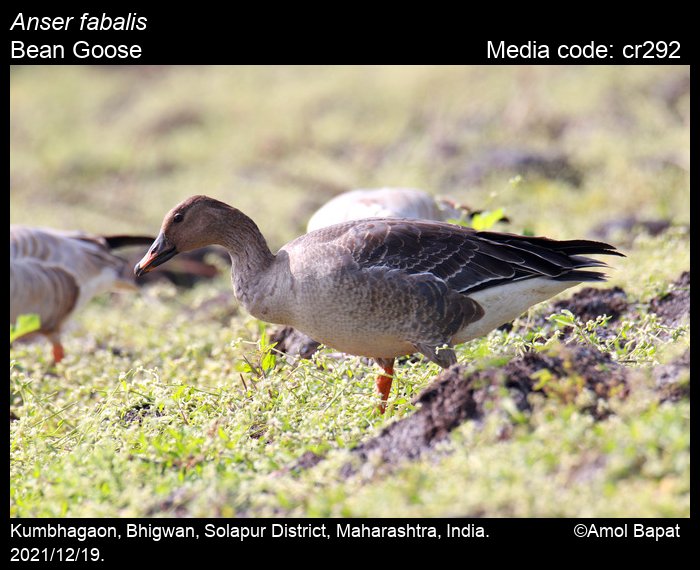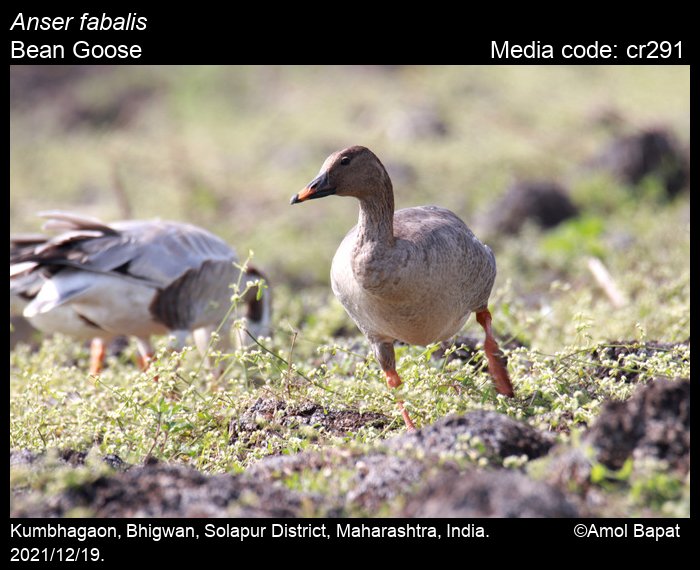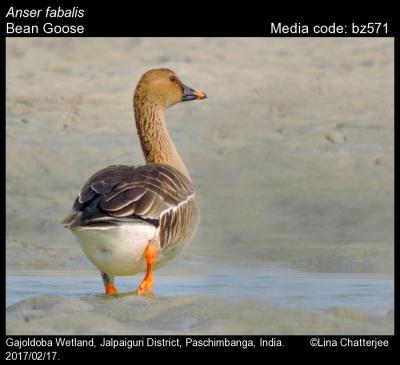
Subspecies in India
Currently, Bean Goose taxonomically exists as follows:
Taiga Bean Goose with three subspecies: Anser fabalis fabalis, Anser fabalis johanseni, and Anser fabalis middendorfii
Tundra Bean Goose with two subspecies: Anser serrirostris serrirostris and Anser serrirostris rossicus
Out of these, Taiga Bean Goose (A. f. fabalis or A. f. johanseni) is reported from India (needs further confirmation on which subspecies occurs in India). There are no records of other subspecies and Tundra Bean Goose from India yet.
Photo Gallery and Species Biology
Breeding Season: May to June. Extralimital (Tundra shores of Arctic Russia and Siberia west of Taimyr Peninsula).
Nest: Nests made of twigs and grasses on ground.
Eggs: 3-5 eggs in a clutch
Identification:
This species is a vagrant visitor to India. It has occured rarely in India (mainly northern India) and only as one or two individuals along with gregarious flocks of Greylag or Bar-headed geese.
Foraging Behaviour: Extensively herbivorous diet that consists of grasses, roots, stems, and cereals
Call/Song: Loud high-pitched honking.
Migration Status: Migratory, rare winter visitor to India.
IUCN Status: Least Concern
| State | Jan | Feb | Mar | Apr | May | Jun | Jul | Aug | Sep | Oct | Nov | Dec | No date |
|---|---|---|---|---|---|---|---|---|---|---|---|---|---|
| Andaman and Nicobar Islands | |||||||||||||
| Andhra Pradesh | |||||||||||||
| Arunachal Pradesh | |||||||||||||
| Assam | |||||||||||||
| Bihar | |||||||||||||
| Chandigarh | |||||||||||||
| Chhattisgarh | |||||||||||||
| Dadra & Nagar Haveli | |||||||||||||
| Daman & Diu | |||||||||||||
| Delhi | |||||||||||||
| Goa | |||||||||||||
| Gujarat | |||||||||||||
| Haryana | |||||||||||||
| Himachal Pradesh | |||||||||||||
| Jammu and Kashmir UT | |||||||||||||
| Jharkhand | |||||||||||||
| Karnataka | |||||||||||||
| Kerala | |||||||||||||
| Ladakh UT | |||||||||||||
| Lakshadweep | |||||||||||||
| Madhya Pradesh | |||||||||||||
| Maharashtra | 3 | ||||||||||||
| Manipur | |||||||||||||
| Meghalaya | |||||||||||||
| Mizoram | |||||||||||||
| Nagaland | |||||||||||||
| Odisha | |||||||||||||
| Paschimbanga | |||||||||||||
| Pondicherry | |||||||||||||
| Punjab | |||||||||||||
| Rajasthan | |||||||||||||
| Sikkim | |||||||||||||
| Tamil Nadu | |||||||||||||
| Tripura | |||||||||||||
| Uttar Pradesh | |||||||||||||
| Uttarakhand | |||||||||||||
| West Bengal | 1 | 1 | |||||||||||
| Total | 1 | 1 | 3 |
1. Rasmussen, P. C., and J. C. Anderton. 2005. Birds of South Asia: The Ripley Guide. Washington, DC.
2. Ali, S., and S. D. Ripley. 1978. Handbook of the Birds of India and Pakistan: Together with those of Nepal, Sikkim, Bhutan and Ceylon (Vol. 1). Oxford University Press.
3. Stuart Baker, E. C. 1933. The Nidification of Birds of the Indian Empire. Taylor And Francis.
Page citation
Anonymous 2025. Anser fabalis (Latham, 1787) – Bean Goose. In Satose, V., A. Bayani, V. Ramachandran, P. Roy, and K. Kunte (Chief Editors). Butterflies of India, v. 2.17. Published by the Indian Foundation for Butterflies. URL: https://www.birdsofindia.org/anser-fabalis, accessed 2025/10/31.
